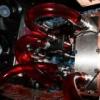James, this is a very rare occasion. I believe you are confused!

You see, the way the FSB:memory clock works, if you set the ratio 1:1, the memory clock (not the memory timings, those are completely different) would have to be equal to the FSB. This is NOT taking into account for the quad-pumping of the FSB or the double data rate of the DDR2. So, with my E6750 and my DDR2-800, it a 1:1 ratio would cause my DDR2-800 to try and perform at DDR2-1333 speeds. Obviously, they cannot do this. What you are thinking of is what my motherboard (680i) calls "sync mode". It is effectively a 2:1 ratio. So, if my FSB was 1600mhz, my memory clock would be 800mhz.
You see, the reason why it doesn't take into account quad-pumping and double data rate is this: For instance, a 1600mhz FSB has an underlying actual speed of 400mhz, but it can send 4 instructions at once. A 800mhz memory clock has an underlying actual speed of 400mhz as well, but it can only send 2 instructions at once. If you think of it like this, you can see that, although they are at the same underlying speed, the FSB would be trying to get 2 more instructions at once than the memory could give it. As you can see, this is not a true 1:1 ratio.
Now, if you keep the 1600mhz FSB (underlying 400mhz, 4 instructions at once), but get memory running at 1600mhz as well, then the memory has an underlying speed of 800mhz (still able to send only 2 instructions at once). But now, since the memory is going twice as fast as the FSB, it can send instructions twice as fast. So, to the FSB, it is like the memory is able to send 4 instructions at once. This is a true 1:1 ratio.
Also, like soorena said, my mobo also has an "unlinked" option, in which there is no set ratio between the FSB and the memory clock.
Hopefully that cleared some things up for everyone.



















 Sign In
Sign In Create Account
Create Account

